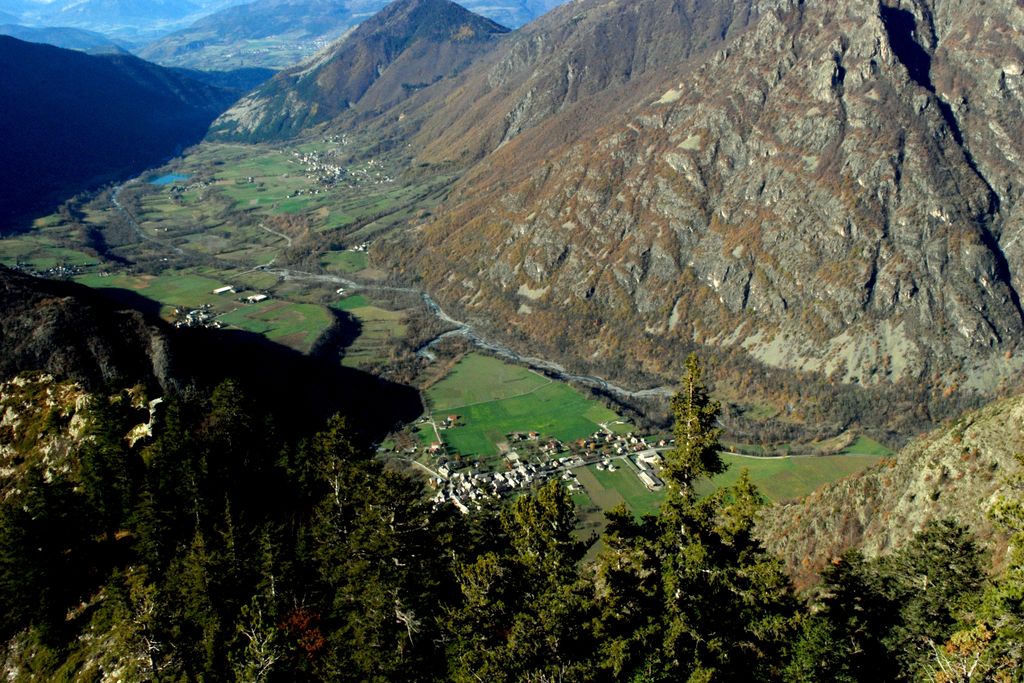
Jas des Agneaux via Pissard des Aiguilles
On a carpet of pine needles and leaves, you make your way along a winding path for a long distance. The typical north-facing slope of the forest provides humidity and coolness, excepting in rare places where the sun’s rays peep through the gaps made by uprooted trees after the storm of 5 January 2012.
Bernard Nicollet, Ecrins National Park keeper
Description
The car park - in a cul de sac - is 300 m after the Dessous la Roche car park. From there, under a large beech tree, follow the marked footpath along an uneven forest trail, then turn right onto a small path marking the real entrance to the forest and the heart of the Ecrins Park. From there, follow the path for a long distance across the Combe de La Géline as far as the Pissard des Aiguilles, and you finally arrive in lush sub-Alpine grassland. After three loops through the prairie, you reach the Jas des Agneaux, at point 1893m. Take the same route on the way back or the Vêt - Lac Gary route, arriving at the village of Entraigues, 4 km downstream from Dessous la Roche.
- Departure : Dessous la Roche
- Arrival : Dessous la Roche or Entraigues
- Towns crossed : Le Périer and Entraigues
21 points of interest
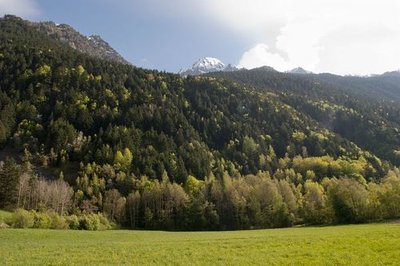
Forêt hêtraie-sapinière d'ubac - Dominique Vincent - PNE  Flora
FloraNorth-facing forest
This grows in the mountains up to 1,800 metres above sea level, on the steep slopes which receive the least sunshine, so not excessively dry in the summer period. It stores the water from saturated soils, stabilises the slopes and holds back the snow layer in winter. It hosts a variety of plant life, including mosses, ferns, lichens and a few flowering plants which collapse due to the low light levels. It is primarily made up of giant softwood trees with evergreen needles, among which beech and maple make the most of their protection.
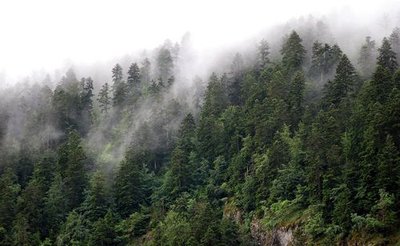
Brume dans la sapinière d'ubac - Dominique Vincent - PNE  Flora
FloraSilver fir and spruce
The silver fir can reach an impressive height exceeding 40 metres. It can be recognised by the flat, blunt leaves which cover its branches, its cones standing on the ends like candles. The spruce competes in height with the fir, and they often grow together, in particular in parts of the forest at higher altitude. Sharp needles and deciduous cones hanging down from the branches are clear identifying features of the spruce.

Mousses Buxbaumia viridis - Cédric Dentant - PNE  Flora
FloraGreen shield-moss
This tiny iconic moss is only visible to the naked eye in early spring when the green spore-containing capsules are forming. It is a pioneer moss, developing on decomposing dead tree trunks in cool, damp forests. In the forestry sector, they pay close attention to it because it is a sign that the forest is in good health.
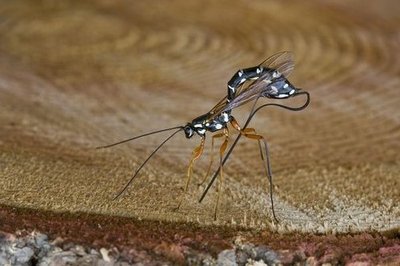
Grand ichneumon ou rhysse persuasive - Bernard Nicollet - PNE  Fauna
FaunaGiant ichneumon wasp or Rhyssa persuasoria ("pursuasive burglar")
Although it appears to have formidable weaponry, this beautiful wasp is harmless and its pseudo-sting is nothing more than its egg-laying organ, its « ovipositor ». It is capable of laying its eggs several centimetres into the bark and wood, inside the bodies of larvae it detects there (who knows how?), so that they can feed on their hosts... perhaps the larvae of the long-horned beetle!
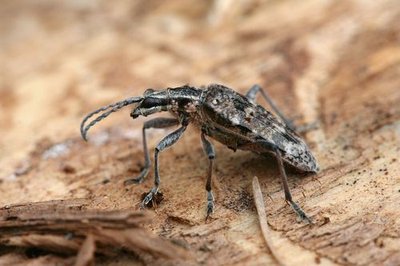
Rhagie inquisitrice - Bernard Nicollet - PNE  Fauna
FaunaRhagium inquisitor beetle
Any tree passing from life into death is of interest to this beetle. This longhorn beetle lays all its eggs under the bark of dead conifers. Its plump yellowish larvae live in a kind of cosy nest made from sawdust, which their strong mandibles have no problem in creating around it.

Fourmi gâte-bois - Bernard Nicollet - PNE  Fauna
FaunaCarpenter ant or gâte bois (literally "wood spoiler”)
Much less active and prolific than the red wood ant, which builds enormous domes of pine needles not far from here, the carpenter ant is very large and lives in old, decomposing stumps. It very seldom ventures above ground because there is plenty to eat, in the form of worms and decomposer insects, in the humus and among the dead leaves.
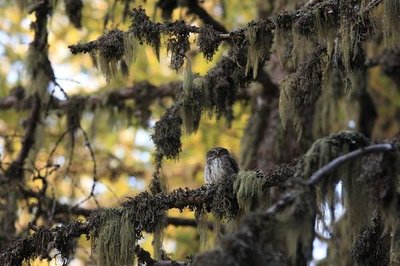
Chevêchette d'Europe - Marc Corail - PNE  Fauna
FaunaEurasian pygmy owl and boreal owl
Both are small owls favouring original boreal forest, which, with good reason, choose to live in stands of conifers where they take over the nests of black woodpeckers and spotted woodpeckers. At dusk, they hunt small mammals and nestlings. During the day, hidden and motionless in their nests or in clumps of lichen handing from the branches of fir trees, they doze and keep a watchful eye on you without you being aware of them.
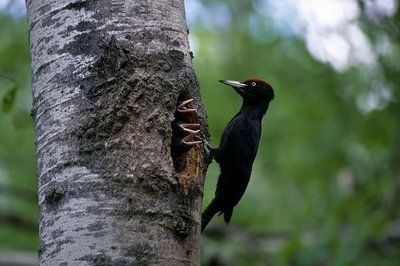
Pic noir et ses petits au nid - Robert Chevalier - PNE  Fauna
FaunaBlack woodpecker
The "estate agent" of the forest, this large woodpecker reduces the trunks of large trees to shavings, in order to extract the insects and grubs concealed within. It feeds, builds its nest and shelters in the tree and then moves on, making way for new opportunistic occupants: martens, bats and forest-dwelling owls.
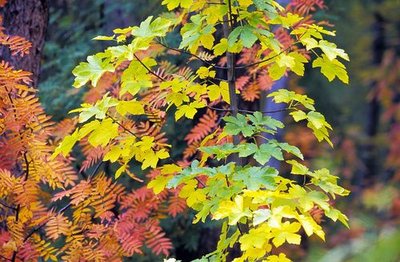
Sorbier des oiseleurs et érable sycomore - Marc Corail - PNE  Flora
FloraRavine forest
This form of vegetation covers the dampest areas of the forest. Combes, avalanche corridors and washlands (land washed periodically by overflowing streams) are all likely environments for its development. The sycamore maple is to be found here, its deciduous foliage varying from yellow to orangey hues in autumn bringing a splash of colour to the shadowy green of the large conifers growing alongside it. Its robust root system allows it to grow between boulders and on screes. Its large leaves with five pointed lobes can be confused with the plane tree grown in our towns and cities.

Fougère - Mireille Coulon - PNE  Flora
FloraMale and female ferns
Damp rocks and obscurity suit these two large ferns which grow in clumps. Distinguishing between them is not a matter of sex, but rather an examination of the characteristics specific to two clearly distinct species. Their fronds, which is what their leaves are called, only die back when new fronds first start to appear in spring.
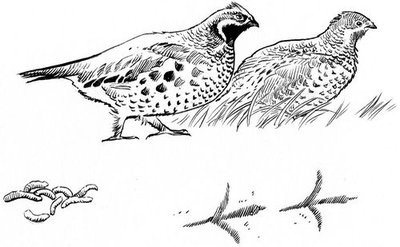
Couple de gélinottes des bois, empreintes et crottes - Pierre-Emmanuel Dequest  Fauna
FaunaHazel grouse
You will be lucky to see one of these birds, because they are extremely timid and they prefer to keep to the forest cover. It very rarely flies, preferring to run away, «fleet of foot» from any danger. It feeds on shoots, willow catkins and rowan berries. So it is no surprise that they have chosen this habitat!
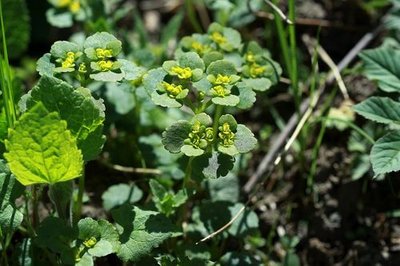
Dorine à feuilles alternes - Cédric Dentant - PNE  Flora
FloraMegaphorb
A transitional zone at the upper margins of the forest, the megaphorb is an area with communities of exuberant plants with broad leaves, seeking sunlight to ensure their development. Under the cover provided by this vegetation, a miniature world of animals and plants make the most of the conditions. The dorine protected in the Provence-Alpes-Côte d’Azur region, it is restricted to the few wet areas of this region. In the extreme west of the Les Écrins massif, it is found on the banks of mountain streams and brooks. Here, just after the snow melt, it lifts up its golden head forming beautiful carpets.

Oreina gloriosa sur adénostyle - Bernard Nicollet - PNE  Flora
FloraAdenostyles alliariae
It's most impressive feature is not its rather ordinary flowers, but the size of its thick leaves which can reach a full half-metre in diameter. Like an inverted Chinese hat, it collects rain and dew as hikers with soaked legs know all too well! But they are also a valuable feeding station for a multitude of green and blue leaf beetles which literally turn them into plant lace.
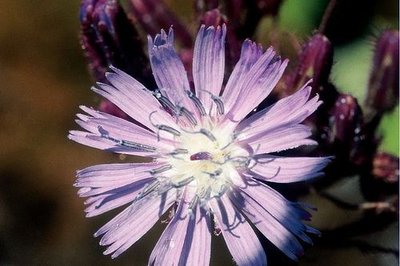
Laitue des Alpes - Bernard Nicollet - PNE  Flora
FloraAlpine sow-thistle - the alpine lettuce
As tall as a person, its purplish blue flower heads remind us that it is perhaps the ancestor of the garden lettuce. It contributes to the lushness of the environment thanks to its height and its innumerable leaves dissected into pike shapes, but graciously welcoming onto its flower heads butterflies and beetles of all shapes and sizes.
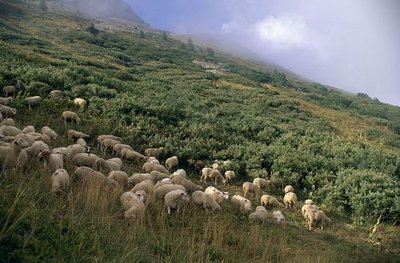
Troupeau dans les aulnes verts - Bernard Nicollet - PNE  Flora
FloraGreen alder groves
The spectacular transition between the forest proper and the alpine meadows on the north-facing slopes, these groves constitute a dense formation of shrubs, primarily made up of willows and green alders. The green alders are destined never to reach the height of a tree. They form impenetrable thickets where tunnels have been carved out by cover-seeking boar, chamois and deer. Providers of nitrogen through their roots, they fertilise the soil to the point of hosting the last incursions of the high megaphorb.
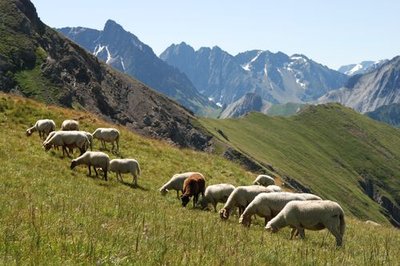
Troupeau de brebis - Bernard Nicollet - PNE  Pastoralism
PastoralismJas des Agneaux - "Lambs' hut"
In the summer months, shepherds from the nearby Vêt alpine meadows drive their flocks to this important grazing location. The grass here is fine, palatable and easily accessible. The sheep in particular have been enjoying it for centuries. So it's not surprising that this place bears such an appropriate name.
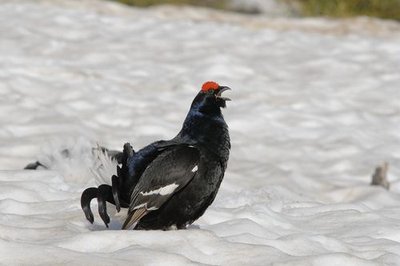
Parade de tétras lyre - Rodolphe Papet - PNE  Fauna
FaunaBlack grouse
The weight of this fowl-like mountain bird varies from 700 to 1,500 grams, depending on sex. It favours thickets where it nests on the ground hidden from predators, and clearings, where the males display noisily from March onwards, splaying their lyre-shaped tail feathers.
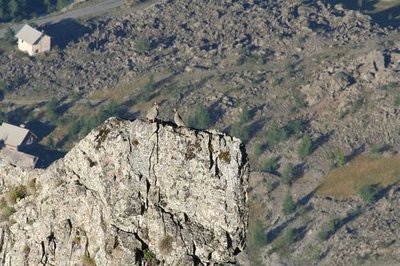
Perdrix bartavelles, sous le Lambert - Jean-Philippe Telmon - PNE  Fauna
FaunaRock partridge
Outside the spring display season when the male calls incessantly, this species is difficult to spot. Yet this curious bird likes to take up a watching position on ridges and promontories, at risk of being seized by the golden eagle.

Merle à plastron - Pierre Dumas - PNE  Fauna
FaunaThe ring ouzel
The ring ouzel has chosen the upper margin of the forest as its home, a little lower down than the rock thrush and higher up than the blackbird. With a white bib and a distinctive alarm call, this migratory bird pecks at the earth for insects, devours cranberries in the nearby mountains heathland, competes with the song of the marsh warbler in the alders and chases away the nutcracker as it gets too close it his nest the Swiss pine... all in a day's work for an ouzel!

Pulsatille de Haller - Cédric Dentant - PNE  Flora
FloraBrow ridges
These are home to highly specific plants which are adapted to extreme weather conditions. Violent winds, little snow and polar temperatures. Flowering shortly after the snowmelt, the Heller's anemone, an anemone with silky « fur » ", thumbs its nose at the difficult conditions that reign here. It constitutes a smile in a prostrate and shrivelled plant world. We must admire it without picking it: its rarity has earned it national protection.
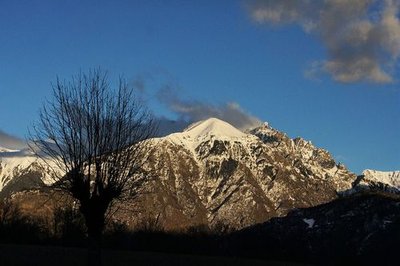
Le Vêt - Ludovic Imberdis - PNE  Panorama
PanoramaView over the Southern Alps
Standing at the western edge of the Les Écrins massif, the Jas des Agneaux offers a unique panorama over the Le Dévoluy massif, the mountains of the lower Valbonnais, the Matheysin plateau and the Vercors. As your eyes sweep from left to right, you can see Le Gargas, Le Colombier, L'Obiou, Mont Aiguille, Le Grand Veymont and the cliffs of the Vercors, L'Etilier and Le Coiro.
Forecast
Altimetric profile
Recommandations
 In mountain pastures, protection dogs are there to protect the herds from predators (wolves, etc.).
In mountain pastures, protection dogs are there to protect the herds from predators (wolves, etc.).
When I hike I adapt my behavior by going around the herd and pausing for the dog to identify me.
Find out more about the actions to adopt with the article "Protection dogs: a context and actions to adopt".
Tell us about your meeting by answering this survey.
Information desks
Maison du Parc du Valbonnais
Place du Docteur Eyraud, 38740 Entraigues
Reception, information, temporary exhibition room, reading room and video-projection on demand. Shop: products and works of the Park. Free admission. All animations of the Park are free unless otherwise stated.
Access and parking
D526 - La Mure - Valbonnais - Col d'Ornon.
Parking :
More information
Source

Report a problem or an error
If you have found an error on this page or if you have noticed any problems during your hike, please report them to us here:


